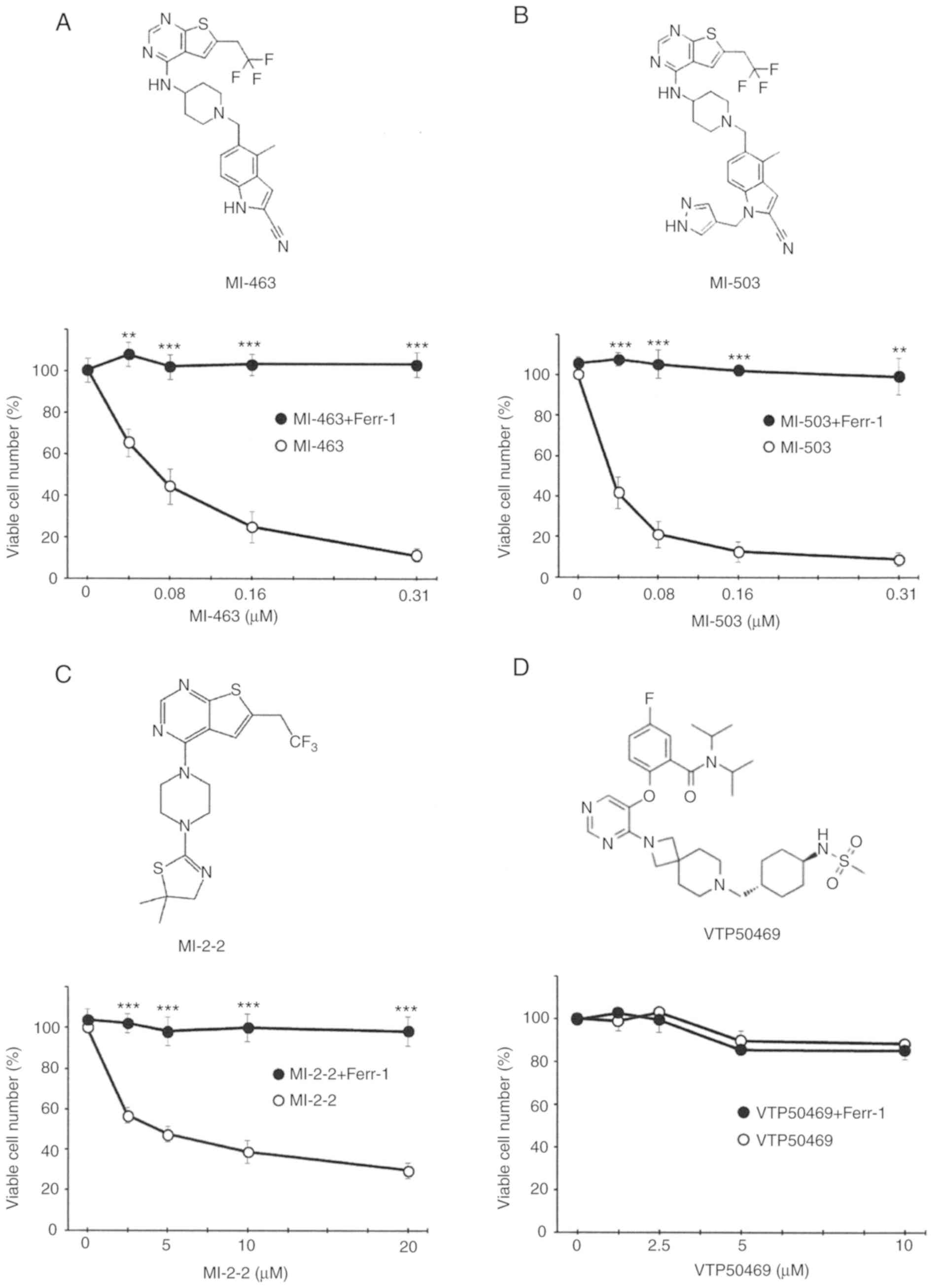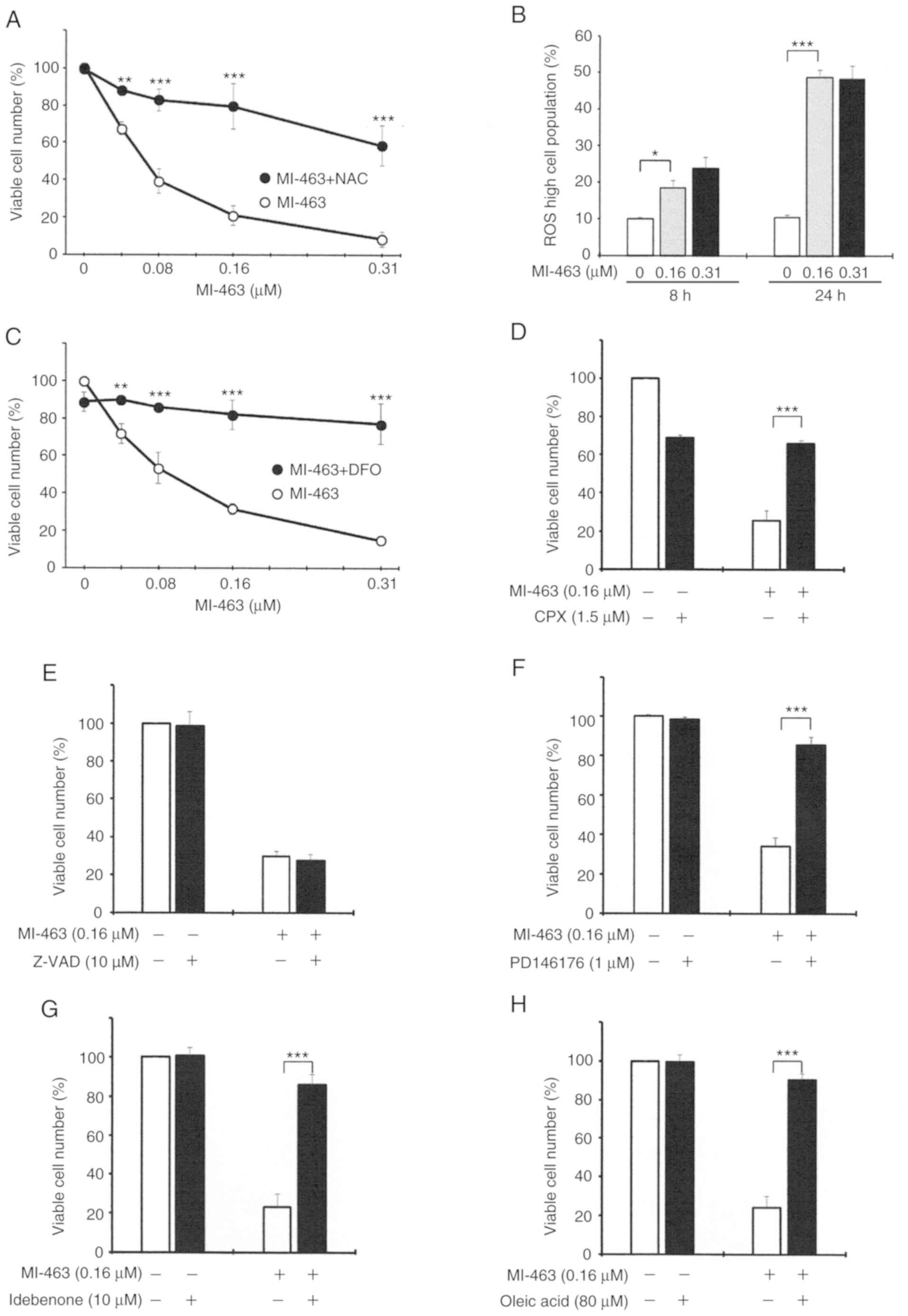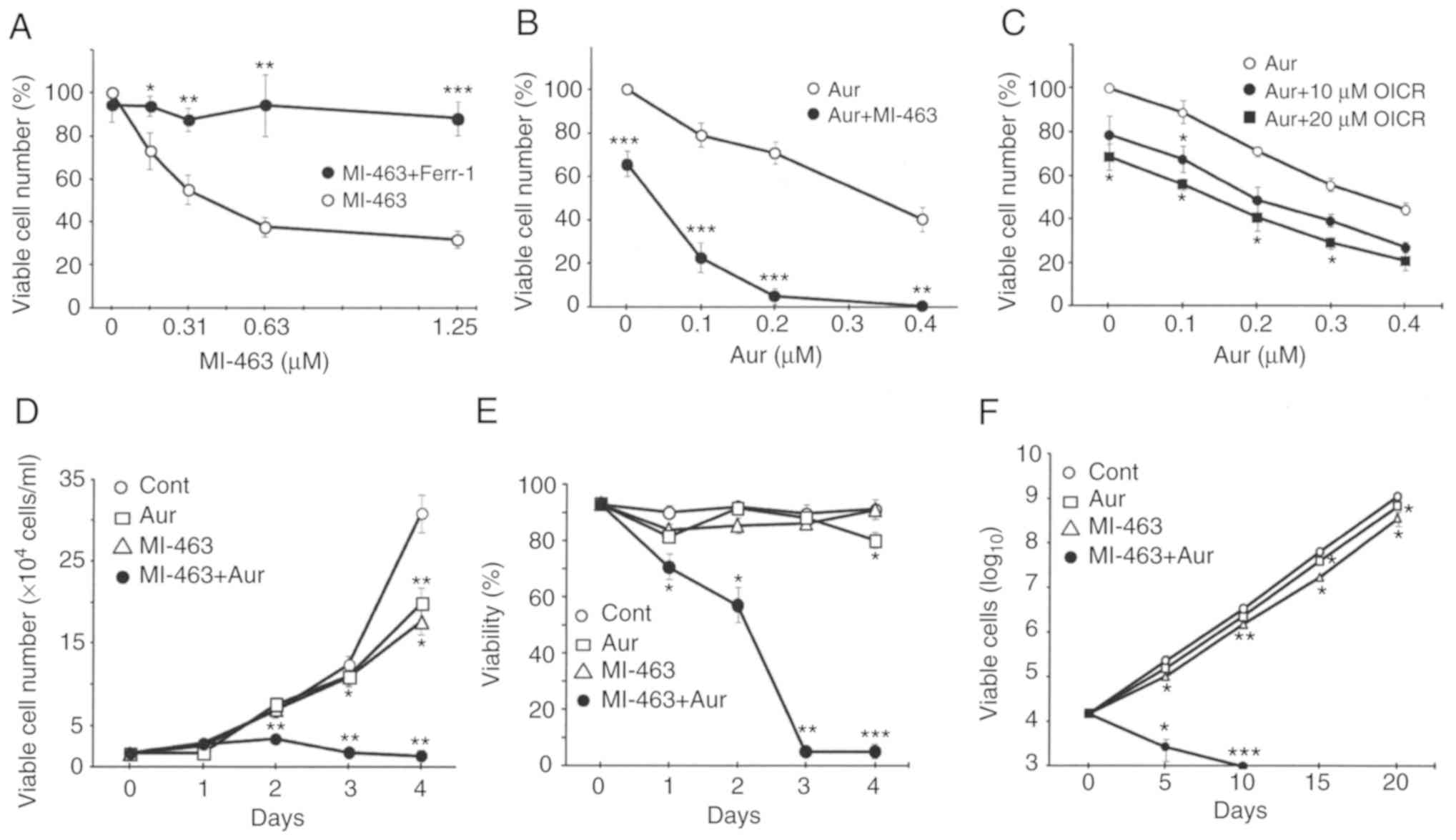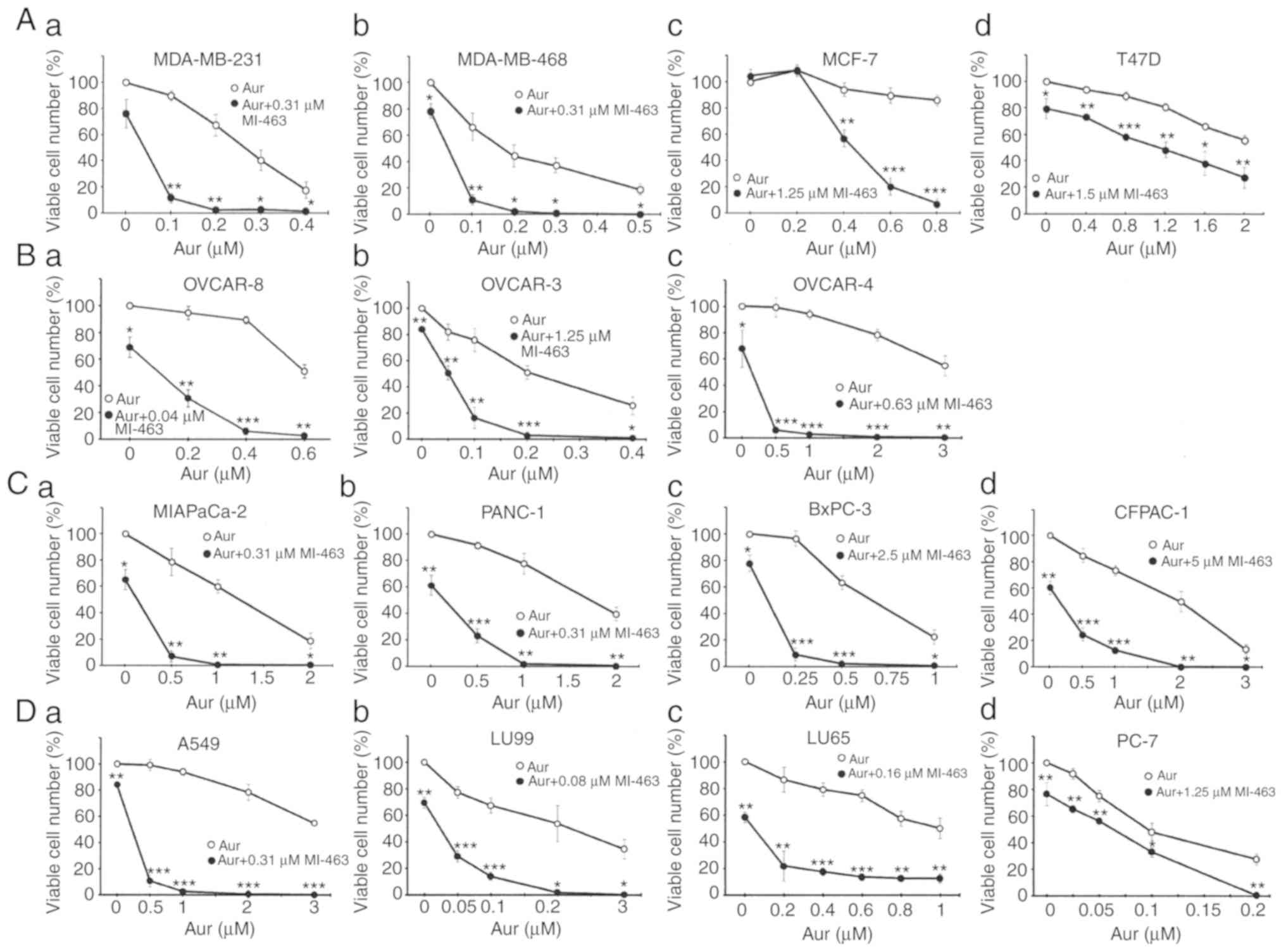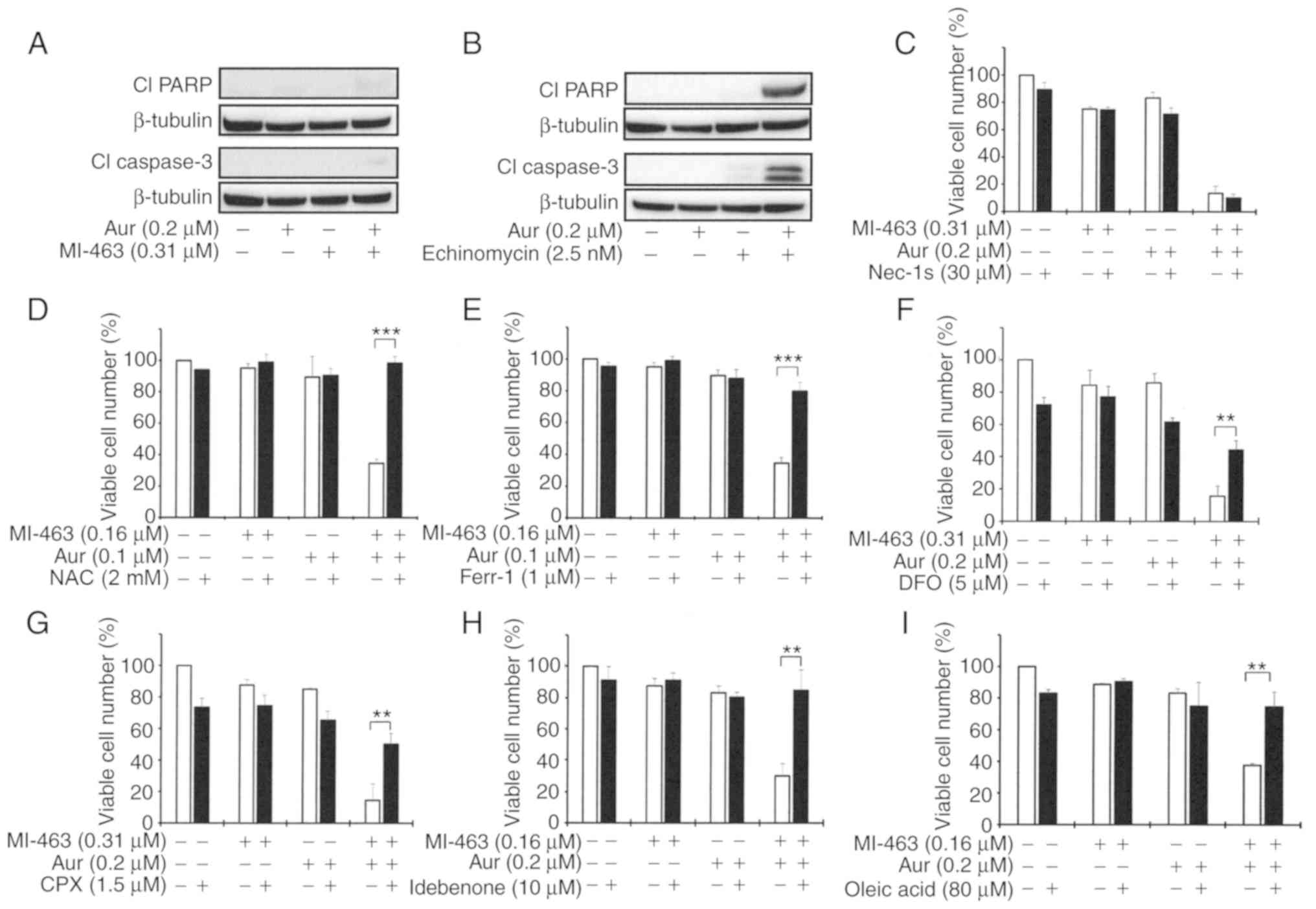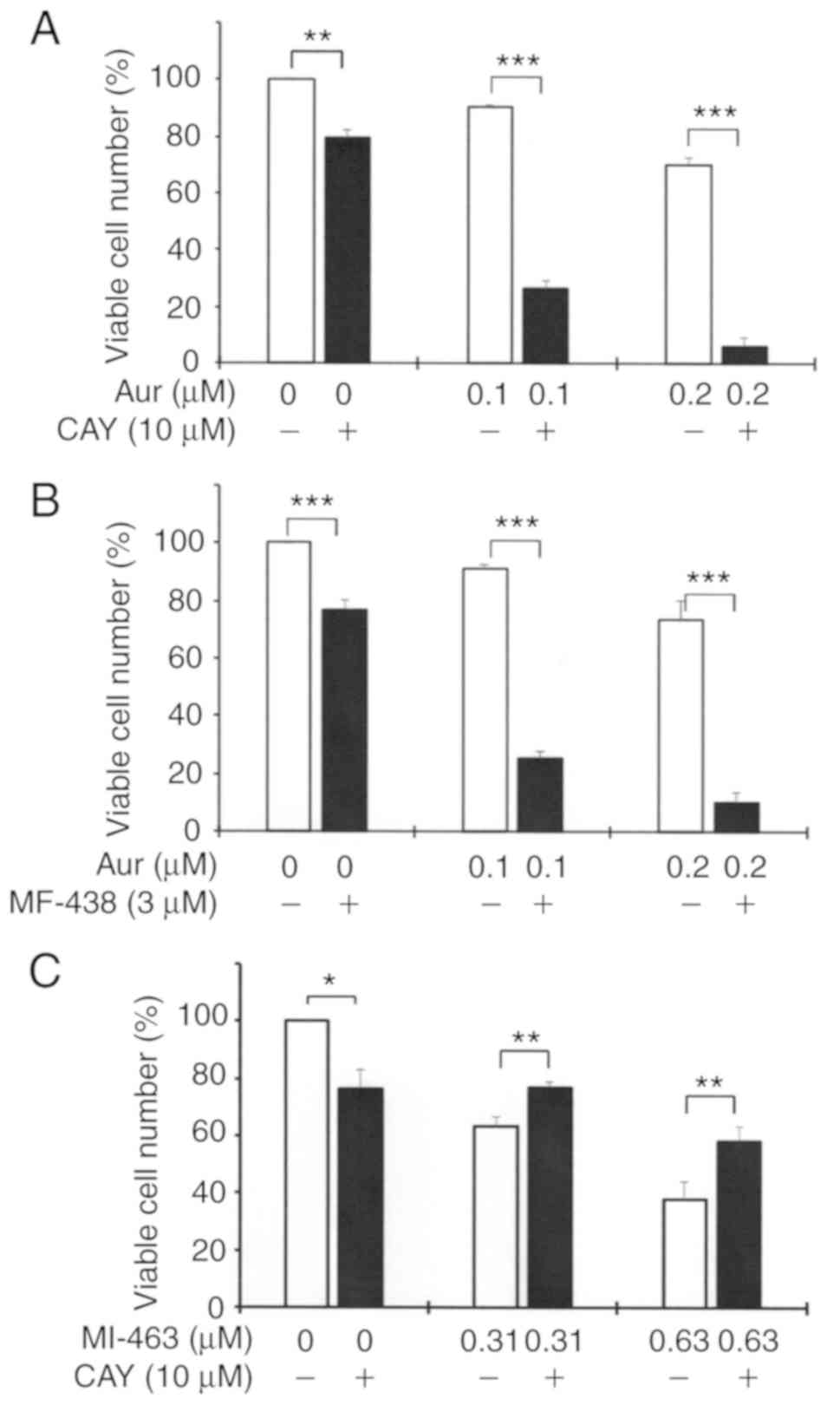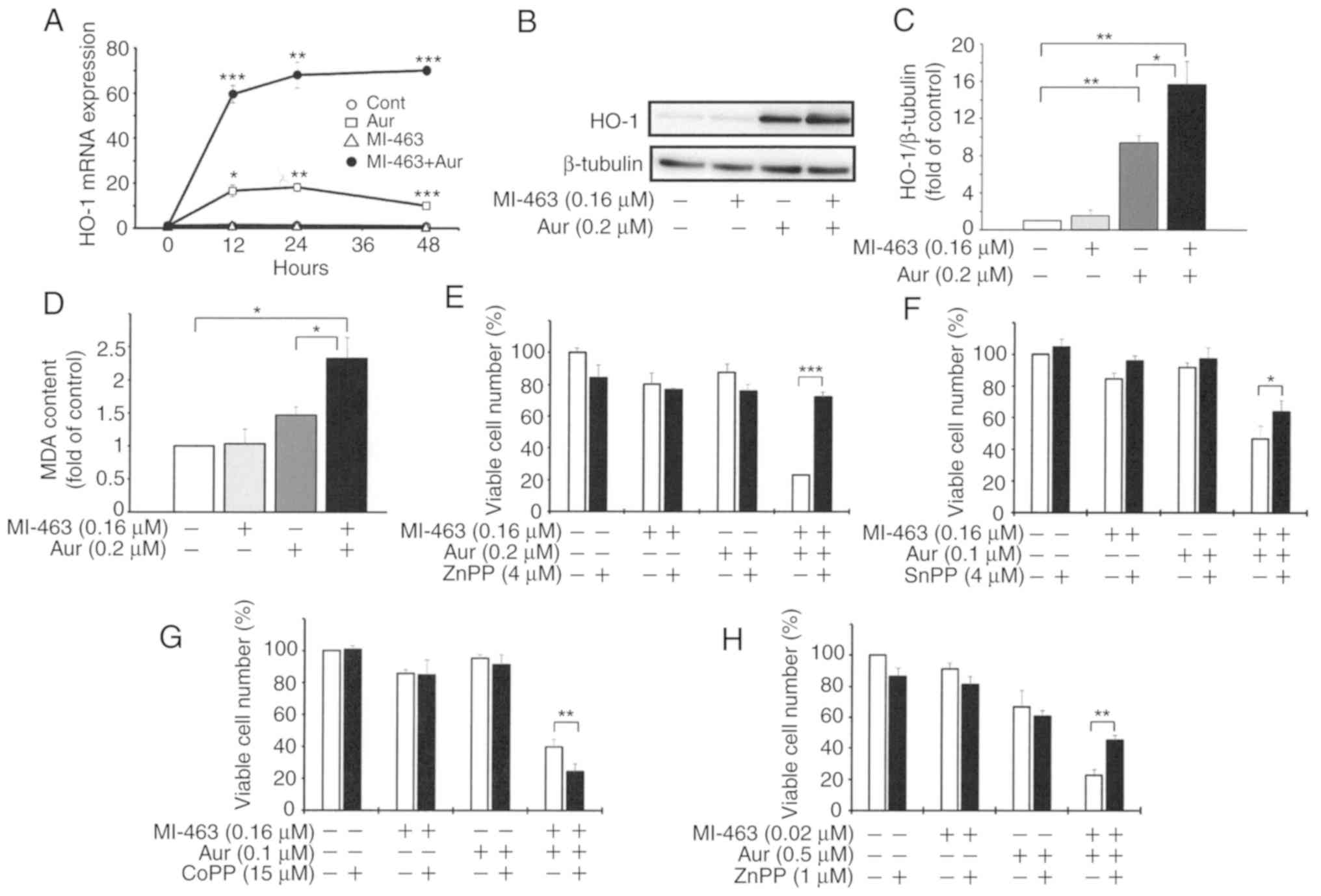|
1
|
Dawson MA and Kouzarides T: Cancer
epigenetics: From mechanism to therapy. Cell. 150:12–27. 2012.
View Article : Google Scholar : PubMed/NCBI
|
|
2
|
Zhu J, Sammons MA, Donahue G, Dou Z,
Vedadi M, Getlik M, Barsyte-Lovejoy D, Al-awar R, Katona W,
Shilatifard A, et al: Gain-of-function p53 mutants co-opt chromatin
pathways to drive cancer growth. Nature. 525:206–211. 2015.
View Article : Google Scholar : PubMed/NCBI
|
|
3
|
Borkin D, He S, Miao H, Kempinska K,
Pollock J, Chase J, Purohit T, Malik B, Zhao T, Wang J, et al:
Pharmacologic inhibition of the Menin-MLL interaction blocks
progression of MLL leukemia in vivo. Cancer Cell. 26:589–602. 2015.
View Article : Google Scholar
|
|
4
|
Krivtsov AV, Evans K, Gadrey JY, Eschle
BK, Hatton C, Uckelmann HJ, Ross KN, Perner F, Olsen SN, Pritchard
T, et al: A menin-MLL inhibitor induces specific chromatin changes
and eradicates disease in models of MLL-rearranged leukemia. Cancer
Cell. 36:660–673.e11. 2019. View Article : Google Scholar : PubMed/NCBI
|
|
5
|
Klossowski S, Miao H, Kempinska K, Wu T,
Purohit T, Kim E, Linhares BM, Chen D, Jih G, Perkey E, et al:
Menin inhibitor MI-3454 induces remission in MLL1-rearranged and
NPM1-mutated models of leukemia. J Clin Invest. 130:981–997. 2020.
View Article : Google Scholar
|
|
6
|
Dreijerink KMA, Groner AC, Vos ESM,
Font-Tello A, Gu L, Chi D, Reyes J, Cook J, Lim E, Lin CY, et al:
Enhancer-mediated oncogenic function of the menin tumor suppressor
in breast cancer. Cell Rep. 18:2359–2372. 2017. View Article : Google Scholar : PubMed/NCBI
|
|
7
|
Malik R, Khan AP, Asangani IA, Cieślik M,
Prensner JR, Wang X, Iyer MK, Jiang X, Borkin D, Escara-Wilke J, et
al: Targeting the MLL complex in castration-resistant prostate
cancer. Nature Med. 21:344–352. 2015. View Article : Google Scholar : PubMed/NCBI
|
|
8
|
Svoboda LK, Bailey N, Van Noord RA, Krook
MA, Harris A, Cramer C, Jasman B, Patel RM, Thomas D, Borkin D, et
al: Tumorigenicity of Ewing sarcoma is critically dependent on the
trithorax proteins MLL1 and menin. Oncotarget. 8:458–471. 2017.
View Article : Google Scholar
|
|
9
|
Kempinska K, Malik B, Borkin D, Klossowski
S, Shukla S, Miao H, Wang J, Cierpicki T and Grembecka J:
Pharmacologic inhibition of the menin-MLL interaction leads to
transcriptional repression of PEG10 and blocks hepatocellular
carcinoma. Mol Cancer Ther. 17:26–38. 2017. View Article : Google Scholar
|
|
10
|
Dixon SJ, Lemberg KM, Lamprecht MR, Skouta
R, Zaitsev EM, Gleason CE, Patel DN, Bauer AJ, Cantley AM, Yang WS,
et al: Ferroptosis: An iron-dependent form of nonapoptotic cell
death. Cell. 149:1060–1072. 2012. View Article : Google Scholar : PubMed/NCBI
|
|
11
|
Viswanathan VS, Ryan MJ, Dhruv HD, Gill S,
Eichhoff OM, Seashore-Ludlow B, Kaffenberger SD, Eaton JK, Shimada
K, Aguirre AJ, et al: Dependency of a therapy-resistant state of
cancer cells on a lipid peroxidase pathway. Nature. 547:453–457.
2017. View Article : Google Scholar : PubMed/NCBI
|
|
12
|
Hangauer MJ, Viswanathan VS, Ryan MJ, Bole
D, Eaton JK, Matov A, Galeas J, Dhruv HD, Berens ME, Schreiber SL,
et al: Drug-tolerant persister cancer cells are vulnerable to GPX4
inhibition. Nature. 551:247–250. 2017. View Article : Google Scholar : PubMed/NCBI
|
|
13
|
Stockwell BR, Friedmann Angeli JP, Bayir
H, Bush AI, Conrad M, Dixon SJ, Fulda S, Gascón S, Hatzios SK,
Kagan VE, et al: Ferroptosis: A regulated cell death nexus linking
metabolism, redox biology, and disease. Cell. 171:273–285. 2017.
View Article : Google Scholar : PubMed/NCBI
|
|
14
|
Bersuker K, Hendricks JM, Li Z, Magtanong
L, Ford B, Tang PH, Roberts MA, Tong B, Maimone TJ, Zoncu R, et al:
The CoQ oxidoreductase FSP1 acts parallel to GPX4 to inhibit
ferroptosis. Nature. 575:688–692. 2019. View Article : Google Scholar : PubMed/NCBI
|
|
15
|
Doll S, Freitas FP, Shah R, Aldrovandi M,
da Silva MC, Ingold I, Grocin AG, Xavier da Silva TN, Panzilius E,
Scheel CH, et al: FSP1 is a glutathione-independent ferroptosis
suppressor. Nature. 575:693–698. 2019. View Article : Google Scholar : PubMed/NCBI
|
|
16
|
Tesfay L, Paul BT, Konstorum A, Deng Z,
Cox AO, Lee J, Furdui CM, Hegde P, Torti FM and Torti SV:
Stearoyl-CoA desaturase 1 protects ovarian cancer cells from
ferroptotic cell death. Cancer Res. 79:5355–5366. 2019. View Article : Google Scholar : PubMed/NCBI
|
|
17
|
Honma Y, Kasukabe T, Yamori T, Kato N and
Sassa T: Antitumor effect of cotylenin A plus interferon-alpha:
Possible therapeutic agents against ovary carcinoma. Gyncol Oncol.
99:680–688. 2005. View Article : Google Scholar
|
|
18
|
Honma Y, Ishii Y, Yamamoto-Yamaguchi Y,
Sassa T and Asahi K: Cotylenin A, a differentiation-inducing agent,
and IFN-alpha cooperatively induce apoptosis and have an antitumor
effect on human non-small cell lung carcinoma cells in nude mice.
Cancer Res. 63:3659–3666. 2003.PubMed/NCBI
|
|
19
|
Kasukabe T, Okabe-Kado J, Kato N, Sassa T
and Honma Y: Effects of combined treatment with rapamycin and
cotylenin A, a novel differentiation-inducing agent, on human
breast carcinoma MCF-7 cells and xenografts. Br Cancer Res.
7:R1097–R1110. 2005. View Article : Google Scholar
|
|
20
|
Kasukabe T, Honma Y, Okabe-Kado J, Higuchi
Y, Kato N and Kumakura S: Combined treatment with cotylenin A and
phenethyl isothiocyanate induces strong antitumor activity mainly
through the induction of ferroptotic cell death in human pancreatic
cancer cells. Oncol Rep. 36:968–976. 2016. View Article : Google Scholar : PubMed/NCBI
|
|
21
|
Yamaguchi Y, Kasukabe T and Kumakura S:
Piperlongumine rapidly induces the death of human pancreatic cancer
cells mainly through the induction of ferroptosis. Int J Oncol.
52:1011–1022. 2018.PubMed/NCBI
|
|
22
|
Maniwa Y, Kasukabe T and Kumakura S:
Vitamin K2 and cotylenin A synergistically induce monocytic
differentiation and growth arrest along with the suppression of
c-MYC expression and induction of cyclin G2 expression in human
leukemia HL-60 cells. Int J Oncol. 47:473–480. 2015. View Article : Google Scholar : PubMed/NCBI
|
|
23
|
Zhang X, Zheng X, Yang H, Yan J, Fu X, Wei
R, Xu X, Zhang Z, Yu A, Zhou K, et al: Piribedil disrupts the
MLL1-WDR5 inter-action and sensitizes MLL-rearranged acute myeloid
leukemia (AML) to doxorubicin-induced apoptosis. Cancer Lett.
431:150–160. 2018. View Article : Google Scholar : PubMed/NCBI
|
|
24
|
Hu B, Shi C, Xu C, Cao P, Tian Y, Zhang Y,
Deng L, Chen H and Yuan W: Heme oxygenase-1 attenuates IL-1β
induced alteration of anabolic and catabolic activities in
intervertebral disc degeneration. Sci Rep. 6:211902016. View Article : Google Scholar
|
|
25
|
Kwon MY, Park E, Lee SJ and Chung SW: Heme
oxygenase-1 accelerates erastin-induced ferroptotic cell death.
Oncotarget. 6:24393–24404. 2015. View Article : Google Scholar : PubMed/NCBI
|
|
26
|
Chang LC, Chiang SK, Chen SE, Yu YL, Chou
RH and Chang WC: Heme oxygenase-1 mediates BAY 11-7085 induced
ferroptosis. Cancer Lett. 416:124–137. 2018. View Article : Google Scholar
|
|
27
|
Chiang SK, Chen SE and Chang LC: A dual
role of heme oxygenase-1 in cancer cells. Int J Mol Sci. 20:392019.
View Article : Google Scholar
|
|
28
|
Shi A, Murai MJ, He S, Lund G, Hartley T,
Purohit T, Reddy G, Chruszcz M, Grembecka J and Cierpicki T:
Structural insights into inhibition of the bivalent menin-MLL
interaction by small molecules in leukemia. Blood. 120:4461–4469.
2012. View Article : Google Scholar : PubMed/NCBI
|
|
29
|
Brzezinka K, Nevedomskaya E, Lesche R,
Haegebarth A, Ter Laak A, Fernández-Montalván AE, Eberspaecher U,
Werbeck ND, Moenning U, Siegel S, et al: Characterization of the
Menin-MLL interaction as therapeutic cancer target. Cancers
(Basel). 12:2012020. View Article : Google Scholar
|
|
30
|
Krivtsov AV, Evans K, Gadrey JY, Eschle
BK, Hatton C, Uckelmann HJ, Ross KN, Perner F, Olsen SN, Pritchard
T, et al: A Menin-MLL inhibitor induces specific chromatin changes
and eradicates disease in models of MLL-rearranged leukemia. Cancer
Cell. 36:660–673. 2019. View Article : Google Scholar : PubMed/NCBI
|
|
31
|
Uckelmann HJ, Kim SM, Wong EM, Hatton C,
Giovinazzo H, Gadrey JY, Krivtsov AV, Rücker FG, Döhner K, McGeehan
GM, et al: Therapeutic targeting of preleukemia cells in a mouse
model of NPM1 mutant acute myeloid leukemia. Science. 367:586–590.
2020. View Article : Google Scholar : PubMed/NCBI
|
|
32
|
Onodera T, Momose I and Kawada M:
Potential anticancer activity of auranofin. Chem Pharm Bull
(Tokyo). 67:186–191. 2019. View Article : Google Scholar
|
|
33
|
Park SH, Lee JH, Berek JS and Hu MC:
Auranofin displays anticancer activity against ovarian cancer cells
through FOXO3 activation independent of p53. Int J Oncol.
45:1691–1698. 2014. View Article : Google Scholar : PubMed/NCBI
|
|
34
|
Bajor M, Graczyk-Jarzynka A, Marhelava K,
Kurkowiak M, Rahman A, Aura C, Russell N, Zych AO, Firczuk M,
Winiarska M, et al: Triple combination of ascorbate, menadione and
the inhibition of peroxiredoxin-1 produces synergistic cytotoxic
effects in triple-negative breast cancer cells. Antioxidants
(Basel). 9:3202020. View Article : Google Scholar
|
|
35
|
Kshattry S, Saha A, Gries P, Tiziani S,
Stone E, Georgiou G and DiGiovanni J: Enzyme-mediated depletion of
l-cyst(e)ine synergizes with thioredoxin reductase inhibition for
suppression of pancreatic tumor growth. NPJ Precis Oncol. 3:162019.
View Article : Google Scholar : PubMed/NCBI
|
|
36
|
Li H, Hu J, Wu S, Wang L, Cao X, Zhang X,
Dai B, Cao M, Shao R, Zhang R, et al: Auranofin-mediated inhibition
of PI3K/AKT/mTOR axis and anticancer activity in non-small cell
lung cancer cells. Oncotarget. 7:3548–3558. 2016. View Article : Google Scholar
|
|
37
|
Grebien F, Vedadi M, Getlik M, Giambruno
R, Grover A, Avellino R, Skucha A, Vittori S, Kuznetsova E, Smil D,
et al: Pharmacological targeting of the Wdr5-MLL interaction in
C/EBPα N-terminal leukemia. Nat Chem Biol. 11:571–578. 2015.
View Article : Google Scholar : PubMed/NCBI
|
|
38
|
Chen P, Li X, Zhang R, Liu S, Xiang Y,
Zhang M, Chen X, Pan T, Yan L, Feng J, et al: Combinative treatment
of β-elemene and cetuximab is sensitive to KRAS mutant colorectal
cancer cells by inducing ferroptosis and inhibiting
epithelial-mesenchymal transformation. Theranostics. 10:5107–5119.
2020. View Article : Google Scholar
|
|
39
|
Saloustros E, Mavroudis D and Georgoulias
V: Paclitaxel and docetaxel in the treatment of breast cancer.
Expert Opin Pharmacother. 9:2603–2616. 2008. View Article : Google Scholar : PubMed/NCBI
|
|
40
|
Badgley MA, Kremer DM, Maurer HC,
DelGiorno KE, Lee HJ, Purohit V, Sagalovskiy IR, Ma A, Kapilian J,
Firl CEM, et al: Cysteine depletion induces pancreatic tumor
ferroptosis in mice. Science. 368:85–89. 2020. View Article : Google Scholar : PubMed/NCBI
|
|
41
|
Trachootham D, Alexandre J and Huang P:
Targeting cancer cells by ROS-mediated mechanisms: A radical
therapeutic approach? Nat Rev Drug Discov. 8:579–591. 2009.
View Article : Google Scholar : PubMed/NCBI
|
|
42
|
Gandini NA, Alonso EN, Fermento ME,
Mascaró M, Abba MC, Coló GP, Arévalo J, Ferronato MJ, Guevara JA,
Núñez M, et al: Heme oxygenase-1 has an antitumor role in breast
cancer. Antioxid Redox Signal. 30:2030–2049. 2019. View Article : Google Scholar
|
|
43
|
Han Y, Chen P, Zhang Y, Lu Y, Ding W, Luo
Y, Wen S, Xu R, Liu P and Huang P: Synergy between auranofin and
celecoxib against colon cancer in vitro and in vivo through a novel
redox-mediated mechanism. Cancers (Basel). 11:9312019. View Article : Google Scholar
|















